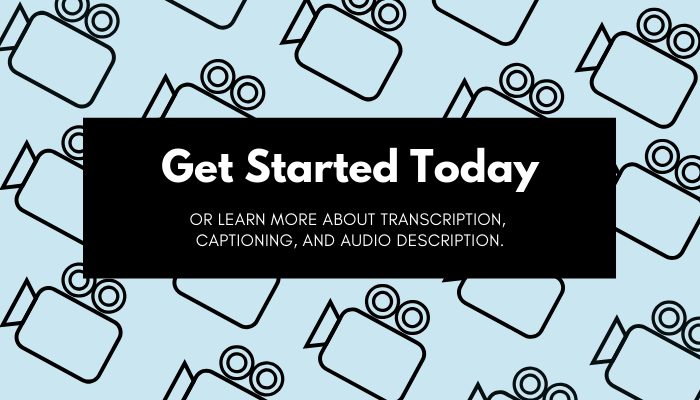How to Choose the Right Video Accessibility Vendor
Updated: July 30, 2019
When choosing a video accessibility vendor, you want to find one that is reliable, accurate, and cost-effective.
The right video accessibility vendor can make a big difference to your operations.
But with many vendors to choose from, it’s easy to get overwhelmed.
Below you’ll find the most important features you should be looking for in a video accessibility vendor.
Services
- Do you offer closed captioning?
- Do you offer transcription?
- Do you offer audio description
Accessible video includes captions, transcripts, and audio description. It’s important to incorporate all these elements to ensure everyone in your audience can watch your videos equally.
Finding a single vendor that offers all these services under one roof will help simplify your workflow substantially; You’ll only need to negotiate one contract, you can order both services at once (or order one later), and you can organize all your video projects in one place.
Quality
- Do you gurantee 99% accuracy on all caption and transcript files?
- How do you measure accuracy?
- What are your standards for audio description quality?
- Do you follow the DCMP Description and Captioning key guidelines?
The quality of your captions, transcripts, and audio description is important for the comprehension and accessibility of your content.
The industry standard for caption and transcript quality is a 99% accuracy rate. And while there isn’t an equivalent accuracy rate for audio description, descriptions should highlight all the important visual elements of a video.
High-quality captions and descriptions should be accurate, complete, synchronized, and distinguishable.
The DCMP Description and Captioning key great guidelines to use when accessing a vendor’s quality. If you are posting to Hulu, Amazon, or Netflix, you should also ensure that a vendor meets their quality standards.
Don’t be afraid to ask vendors if you can see examples or even test a file! This will help you see if a vendor meets your quality standards.
READ: What Is 99% Accuracy, Really?
Process
- How do you caption and describe video files?
- Are single files split between multiple transcriptionist?
- Are transcriptionist trained on quality standards?
- Do you have a quality review process?
- How do you create audio description?
A vendor’s process can directly impact quality, cost, and turnaround.
You’ll want to investigate a vendor’s process for both captioning and describing video content to ensure it’s up to standards.
First, look into who will be handling your video content.
In terms of captioning, you should ask a vendor if they use humans in their process or a mix of technology and humans. If they use humans, you should also ask how their transcriptionist are trained and if the can handle complicated content.
With description, inquire about their standards for dictating what should be described, as well as how describers are trained.
Next, ask about the process.
How are your files handled? Are single fills split among multiple transcriptionists? Are final files reviewed before you receive them?
The most efficient process to get accurate captions is to use a multi-step process of technology and human editing. This process is faster, efficient, and cost-effective.
Workflow
- How can I upload files?
- How can I manage my files?
- Will I be notified when my files are complete?
- How long do my files stay in the account?
- Where do I download files?
Next, ask vendors about their upload and download workflow.
Seek a vendor who offers a seamless upload and download process. An intuitive UX will make all the difference for you and your team.
Ask questions like, how many ways can you upload content? Do they offer integrations and flexible APIs? What’s the ordering process like?
And once your files are complete ask, how will you be notified? What formats can you download? How long will a file be stored? Where can you download and access your files?
You can even ask vendors to show you how your workflow will look like with them.
Flexibility
- What are your turnaround options?
- Can I reprocess files?
- Do you offer ___ format?
Everyone has different needs – whether it’s a specific turnaround option, reprocessing option, or specific formats.
Be specific when talking to vendors and lay out your requirements. This will help ensure that your workflows are as efficient as possible.
Some sample questions include, what is your standard turnaround? What is your fastest turnaround? And can I reprocess files?
Cost
- What is your pricing model?
- What are your extra fees?
- Do you offer bulk discounts?
Cost can vary depending on process, turnaround, order size, and other fees.
You should begin by asking vendors about their pricing model. Make sure you understand if there are any extra fees that are not included in the pricing model (sometimes vendors will charge you extra for speaker IDs or additional formats).
Also, don’t be afraid to ask for bulk discounts – especially if you have – or project to have – a lot of content.
READ: How Much Does a Closed Captioning Service Cost?
Integrations
- What integrations do you offer?
- How do your integrations work?
- How do I set up an integration with ___?
Integrations help to automate your captioning and description process. With an integration, you can eliminate many mundane steps in the process.
An integration works by linking your video player account to your vendor’s account. Once you select the video you want captioned or described, the captions or descriptions will automatically post back onto your video.
Whether you use one video platform or seven, make sure to ask your vendor what platforms they integrate with, how these integrations work, and how to set them up.
Account System
- Do you allow subaccounts?
- How does invoicing work?
- Can you pay within the account?
- Can you have multiple users?
- Can you give users different permissions?
Does a vendor allow for subaccounts? How does invoicing work? Can you pay electronically? Can you have multiple users?
These are all important questions to ask a vendor about their account system.
You want to ensure that the account system can be customized to your needs and that it’s also easy to navigate.
You also want to consider who else will be using the account. Are you a university with multiple departments? Do you want to give everyone a separate username and password?
A good video accessibility vendor should give you the flexibility to help centralize the captioning and description process.
Support
- Do you offer support?
- Can I call, email, or chat?
- How fast is response time?
Knowing you have a dedicated support staff there to back you up when a crisis arises makes a huge difference.
Look for a vendor that not only offers clear documentation but one that also offers multiple ways to get in touch with the support team.
Make sure to also ask about the support team’s response time and average ticket resolution time.
Lastly, seek out reviews to see what customers are saying about the vendor’s support, or ask the vendor what customers rank the support team as.
Making a Decision
Before making a decision, make sure to outline what are your top requirements in a video accessibility vendor.
Furthermore, don’t be afraid to ask if you can demo a file – especially if you are looking to make a substantial commitment. You want to ensure that all your needs and standards are met, otherwise you may be left with additional work.
A good video accessibility vendor can truly make all the difference.







